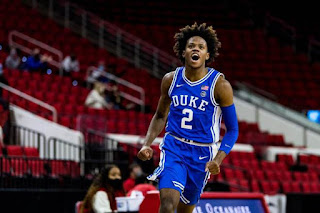NEWS: Henry Coleman will enter transfer portal. pic.twitter.com/fNExRQ53Bd
— Duke Men’s Basketball (@DukeMBB) April 20, 2021
Just when it seemed the Duke roster for next season was finally starting to take shape, the turbulent 2021 college basketball off-season struck yet again. On Tuesday afternoon, it was announced that freshman forward Henry Coleman III would be entering the transfer portal, the fourth Blue Devil to do so in the past month. There's been plenty of personnel turnover in the Duke program recently with the recent influx of one-and-done players, but this amount of players coming and going is unlike anything we’ve ever seen before. What’s perhaps most unfortunate is that I can say with zero confidence that’s it’s unlike anything we’ll ever see again, as this just seems to be the direction college sports are headed.
Coleman’s freshman season at Duke was rather mundane, but he did have a few big moments in home games against North Carolina and Virginia when the team needed a lift. Although he was rather raw offensively and could’ve even been a redshirt candidate in a normal season, Coleman was an incredibly effective defensive player whenever his number was called upon. In the 95 minutes Coleman played, Duke was over 13 points better defensively per 100 possessions. Obviously, that’s a very small sample size, but the eye test backed up Coleman’s impact on that end. Even if his offense didn’t come around in time for the 2021-22 season, he would’ve been a welcome presence on the roster for his energy and effort on both ends.
The immediate question that has to be asked is whether or not the acquisition of Marquette transfer Theo John pushed Coleman out the door. While John is more of a traditional center than Coleman, the two would presumably be competing for the same frontcourt minutes off the bench. Only those inside the program will know the exact order in which these events went down, but if John is the reason for Coleman’s departure, it further emphasizes how badly Coach K has mismanaged players over the past six seasons in order to try and win a sixth championship. If Duke doesn’t win it all this season, this is a bad gamble by the staff, plain and simple.
 |
| Coleman's defensive presence wasn't enough to earn consistent minutes last season. Source: Raleigh News & Observer |
From Coleman’s perspective, this may wind up being a great decision for the development of his career. The failures of late by the Duke coaching staff to develop players ranked outside of the top fifty is no secret. As the 54th-ranked prospect in the 2020 class, Coleman’s development simply was not at the top of the list of priorities. It’s sad to see yet another young player leave who would’ve helped Blue Devil teams in the future, but in the era where kids can transfer and play immediately, who is going to want to sit around and wait multiple seasons for a chance at playing time?
With Coleman’s departure, the six-man 2020 recruiting class that ranked second nationally is down to just two remaining players, Jeremy Roach and Mark Williams. What is the point of bringing in these heralded recruiting classes if the players aren’t even in Durham for a full season? Not since the 2015 class has Duke retained over 50% of its freshmen in a given season and 80% of that group was gone by the end of year two. It’d be one thing if this was a proven model for winning in college basketball, but it simply isn’t. Teams with experience have a big edge in the winner-take-all games of March and April, but the Duke coaching staff doesn’t even seem to care. Sure, experience is easier to attain than ever these days with the transfer portal, but there’s something to be said for groups with roster continuity that have been through the heat of battle together (see Duke's 2010 roster).
Obviously, the 2020-21 team endured plenty of ups and downs on their way to missing the NCAA Tournament for the first time since 1995, but I don’t think anybody could’ve expected this type of roster purge. Counting Jalen Johnson, Duke has now lost seven of their eleven scholarship players from the start of the 2020-21 season and we haven’t even reached May. The transfer portal is closing in on 1,500 names and it’d be naïve to assume this is Duke’s last player to enter it this spring. One thing is clear; the Duke coaching staff is all-in on another run for a championship this season. If any returning player on the roster wasn’t happy with their projected role on the 2021-22 team, they had every right to seek other opportunities. Henry Coleman III did just that and we wish him nothing but the best.








